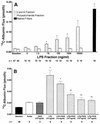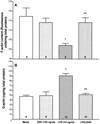Endotoxin-neutralizing protein protects against endotoxin-induced endothelial barrier dysfunction
- PMID: 9529059
- PMCID: PMC108066
- DOI: 10.1128/IAI.66.4.1400-1407.1998
Endotoxin-neutralizing protein protects against endotoxin-induced endothelial barrier dysfunction
Abstract
Bacterial lipopolysaccharide induces tyrosine phosphorylation of paxillin, actin reorganization, and opening of the transendothelial paracellular pathway through which macromoles flux. In this study, lipid A was shown to be the bioactive portion of the lipopolysaccharide molecule responsible for changes in endothelial barrier function. We then studied whether endotoxin-neutralizing protein, a recombinant peptide that is derived from Limulus antilipopolysaccharide factor and targets lipid A, could block the effects of lipopolysaccharide on protein tyrosine phosphorylation, actin organization, and movement of 14C-bovine serum albumin across bovine pulmonary artery endothelial cell monolayers. In the presence of serum, a 6-h exposure to lipopolysaccharide (10 ng/ml) increased transendothelial 14C-albumin flux compared to the simultaneous media control. Coadministration of endotoxin-neutralizing protein (> or =10 ng/ml) with lipopolysaccharide (10 ng/ml) protected against lipopolysaccharide-induced barrier dysfunction. This protection was dose dependent, conferring total protection at endotoxin-neutralizing protein/lipopolysaccharide ratios of > or =10:1. Similarly, endotoxin-neutralizing protein was capable of blocking the lipopolysaccharide-induced endothelial cell responses that are prerequisite to barrier dysfunction, including tyrosine phosphorylation of paxillin and actin depolymerization. Finally, endotoxin-neutralizing protein cross-protected against lipopolysaccharide derived from diverse gram-negative bacteria. Thus, endotoxin-neutralizing protein offers a novel therapeutic intervention for the vascular endothelial dysfunction of gram-negative sepsis and its attendant endotoxemia.
Figures






Similar articles
-
Endotoxin induces endothelial barrier dysfunction through protein tyrosine phosphorylation.Am J Physiol. 1997 Jul;273(1 Pt 1):L217-26. doi: 10.1152/ajplung.1997.273.1.L217. Am J Physiol. 1997. PMID: 9252559
-
Bacterial lipopolysaccharide disrupts endothelial monolayer integrity and survival signaling events through caspase cleavage of adherens junction proteins.J Biol Chem. 1998 Dec 25;273(52):35371-80. doi: 10.1074/jbc.273.52.35371. J Biol Chem. 1998. PMID: 9857080
-
Bacterial lipopolysaccharide induces actin reorganization, intercellular gap formation, and endothelial barrier dysfunction in pulmonary vascular endothelial cells: concurrent F-actin depolymerization and new actin synthesis.J Cell Physiol. 1993 Oct;157(1):13-23. doi: 10.1002/jcp.1041570103. J Cell Physiol. 1993. PMID: 8408232
-
Direct effects of endotoxin on the endothelium: barrier function and injury.Lab Invest. 1999 Oct;79(10):1181-99. Lab Invest. 1999. PMID: 10532583 Review.
-
Peptides with dual mode of action: Killing bacteria and preventing endotoxin-induced sepsis.Biochim Biophys Acta. 2016 May;1858(5):971-9. doi: 10.1016/j.bbamem.2016.01.011. Epub 2016 Jan 20. Biochim Biophys Acta. 2016. PMID: 26801369 Review.
Cited by
-
Modulation of brain hemichannels and gap junction channels by pro-inflammatory agents and their possible role in neurodegeneration.Antioxid Redox Signal. 2009 Feb;11(2):369-99. doi: 10.1089/ars.2008.2130. Antioxid Redox Signal. 2009. PMID: 18816186 Free PMC article. Review.
-
TLR4 signaling is coupled to SRC family kinase activation, tyrosine phosphorylation of zonula adherens proteins, and opening of the paracellular pathway in human lung microvascular endothelia.J Biol Chem. 2008 May 9;283(19):13437-49. doi: 10.1074/jbc.M707986200. Epub 2008 Mar 7. J Biol Chem. 2008. PMID: 18326860 Free PMC article.
-
Interactions between Lipopolysaccharide and Peptide Bacteriocin BacSp222 Influence Their Biological Activities.ACS Infect Dis. 2025 Aug 8;11(8):2116-2130. doi: 10.1021/acsinfecdis.5c00066. Epub 2025 Jul 8. ACS Infect Dis. 2025. PMID: 40625076 Free PMC article.
-
Effects of lipopolysaccharide and Mannheimia haemolytica leukotoxin on bovine lung microvascular endothelial cells and alveolar epithelial cells.Clin Vaccine Immunol. 2008 Feb;15(2):338-47. doi: 10.1128/CVI.00344-07. Epub 2007 Nov 21. Clin Vaccine Immunol. 2008. PMID: 18032592 Free PMC article.
-
Lipid Droplets Formation Represents an Integral Component of Endothelial Inflammation Induced by LPS.Cells. 2021 Jun 6;10(6):1403. doi: 10.3390/cells10061403. Cells. 2021. PMID: 34204022 Free PMC article.
References
-
- Alpert G, Baldwin G, Thompson C, Wainwright N, Novitsky T J, Gillis Z, Parsonnet J, Fleisher G R, Siber G R. Limulus antilipopolysaccharide factor protects rabbits from meningococcal endotoxin shock. J Infect Dis. 1992;165:494–500. - PubMed
-
- Arditi M, Zhou J, Torres M, Durden D L, Stins M, Kim K S. Lipopolysaccharide stimulates the tyrosine phosphorylation of mitogen-activated protein kinase p44, p42, and p41 in vascular endothelial cells in a soluble CD14-dependent manner. Role of protein tyrosine phosphorylation in lipopolysaccharide-induced stimulation of endothelial cells. J Immunol. 1995;155:3994–4003. - PubMed
-
- Bannerman D D, Goldblum S E. Endotoxin induces endothelial barrier dysfunction through protein tyrosine phosphorylation. Am J Physiol. 1997;273:L217–L226. - PubMed
-
- Battafaraono R J, Dahlberg P S, Ratz C A, Johnston J W, Gray B H, Haseman J R, Mayo K H, Dunn D L. Peptide derivatives of three distinct lipopolysaccharide binding proteins inhibit lipopolysaccharide-induced tumor necrosis factor-alpha secretion in vitro. Surgery. 1995;118:318–324. - PubMed
-
- Brigham K L, Meyrick B. Endotoxin and lung injury. Am Rev Respir Dis. 1986;133:913–927. - PubMed
Publication types
MeSH terms
Substances
LinkOut - more resources
Full Text Sources
Medical

